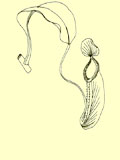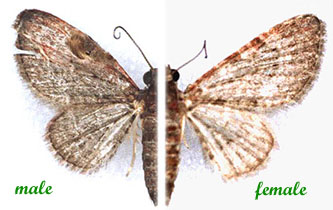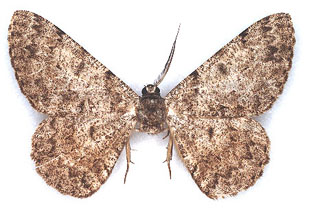
 |
Invertebrates
 New
moth species for Hong Kong, part 5 : update and furthur 1999 records
New
moth species for Hong Kong, part 5 : update and furthur 1999 records
 Orthetrum
poecilops Ris - A marine dragonfly conservation
priority
Orthetrum
poecilops Ris - A marine dragonfly conservation
priority
 Soil
Towers
Soil
Towers
 HELP
(Earthworm)!
HELP
(Earthworm)!
New moth species for Hong Kong, part 5 : update and further 1999 records
by Roger C. Kendrick
Field recording of moths in Hong Kong has been very much reduced during 2000, but the processing of the data obtained from 1999 has yielded further additions to the Hong Kong list. Two visits to Tai Lung Farm, to view the Agriculture, Fisheries & Conservation Department’s moth collection and visits by specialists from overseas have also enabled a clearer picture of the status of some of the rarer species to be obtained. Updated information has clarified the identification of some of the species previously reported in this series (Kendrick, 1998a, 1998d, 1999a, 1999b).
During 2000, several moth taxonomists visited Hong Kong – in February, a leading specialist on Notodontidae from the Oriental Region, Dr. Alexander Schintlmeister (Dresden, Germany), visited The University of Hong Kong (HKU) and deposited material of that family, including paratype specimens, with the HKU collection. These species were collected recently in Vietnam (Schintlmeister, 1997); some of them also occur in Hong Kong and most of the rest could conceivably also occur if looked for at the right time of year in the appropriate habitat. Also visiting HKU in 2000 was Yen Shen-horn (studying for his Ph.D. at Imperial College, The University of London), a specialist in Epipleminae (Uraniidae), Zygaenidae and Pyralidae. During his visits in April and October he viewed the material from those families in the HKU collection and has taken some material for further study. He will at some point be describing some new species as a result. This includes species of Nymphulinae, whose larvae are aquatic and some of which are associated with unpolluted streams (e.g. Eristina sp. nr. bifurcalis). The comments Yen made regarding the species of Zygaenindae have added a good five or six species, including at least two new to science, to the Hong Kong list of this relatively small family. Papers on these matters will be published by Yen in due course.
The visits to Tai Lung Farm have necessitated some corrections from previous notes in Porcupine! on new moth species to Hong Kong. A specimen of Endoclita davidi Poujade, 1886 (mis-identified as E. chalybeatus Moore) (Lep.: Hepialidae) was recorded by Clive Lau from KARC on 18 October 1993, making the record from 1997 (Kendrick, 1998b) the second from Hong Kong. A series of five specimens of Macroglossum saga (Lep.: Sphingidae, Macroglossinae ) also predate the previously noted "first" record (Kendrick, 1998c) for Hong Kong. The first of these is dated 21 October 1992 and was recorded at Tai Lung Farm; the others are from Tai Lung Farm (7 & 10 i 1993, 10 iii 1995) and from Ho Pui (23 ii 1994). Also noteworthy in the collection at Tai Lung Farm are specimens of a clearwing moth (Toleria sinensis Walker [Sesiidae]) only known from Hong Kong and not seen since the 1860's, recorded by Mr. Chan Ping-wing of the Agriculture, Fisheries & Conservation Dept. (AFCD) (H.K. Govt.) from Ma On Shan Country Park. The following information was provided by Stephen Lai (AFCD, Tai Lung Experimental Research Station) by way of Gaden Robinson at the Natural History Museum, London.: "Notes - moth larvae and pupae were collected from the tree trunk of Ormosia pachycarpa at Ma On Shan (Shatin), New Territories, Hong Kong on 24 May 1999. Over 20 trees (Ormosia) were badly affected. One of the most severely affected trees was cut down and part of the tree trunk was brought back to Tai Lung Farm for further observation. Adult moths subsequently emerged over the period of 2-6 June 1999. Entomopathogenic nematodes (Steinernema carpocapsae) were sprayed on the tree trunk as a control measure but no information is available on its efficacy." Let's hope (for the sake of maintaining Hong Kong's endemic wildlife) the nematodes are not too successful!
A check on the older material in the HKU moth collection revealed the presence of an unlabelled specimen of Endoclita sinensis (Moore, 1877) (Lep.: Hepialidae ), another species recently reported as new to Hong Kong (Kendrick, 1998b). This is likely to represent the first record for Hong Kong as most of the unlabelled specimens in the HKU collection are thought to have been taken by D.S. Hill in the 1970’s from the Pok Fu Lam area, but due to the total lack of a data label to confirm this it cannot be accepted as such. Since the first record from KARC, there have been several other records from the New Territories.
 |
| Fig. 1 Endoclita sinensis |
As with previous parts of this series, identifications have been verified by comparison with published sources or with material from The Natural History Museum, London (visited again in July 2000) and records are (unless stated) from mercury-vapour light traps operated overnight at the localities stated.
Sites are abbreviated as follows: KARC – Kadoorie Agricultural Research Centre ; KFBG – Kadoorie Farm & Botanic Garden. All records and deteminations (det.) are by R.C.K unless stated. I would like to thank Martin Honey (MRH) of the Natural History Museum and Tony Galsworthy (ACG) for their determinations of several of the species listed and the Trustees of the Natural History Museum for granting access to the moth collections there.
Pyralidae: Nymphlinae
Thysanoima stellata (Warren, 1896) (Yen, pers. com.); previously noted as Parthenodes stellata and misplaced in Pyraustinae (sensu Kendrick, 1999a).
Geometridae: Larentiinae
Pasiphila viridata Warren (det. ACG – "I have checked out the Pasiphila viridata (?) with Malcolm Scoble [the Natural History Museum]. He says it doesn't match 100%, though is close. The species is based on a single male. Yours, naturally is a female, so there is no way at present of marrying them. My guess is that this is the female, and that there is a slight sexual difference (or it could be geographical), so the best determination for the moment has to be viridata."); previously noted as Pasiphila sp ? palpata (Walker) (sensu Kendrick, 1999b).
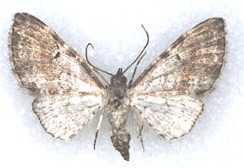 |
Eupithecia sekkongensis Galsworthy, 1999; previously noted as Eupithecia sp. nov. (sensu Kendrick, 1998d) and Eupithecia sp. near ustata (sensu Kendrick, 1998a). This species is still only known from KARC, where it flies between late December and February. |
| Fig .2 Eupithecia sekkongensis |
|
Fig. 3 Sigilliclystis kendricki |
Sigilliclystis kendricki Galsworthy, 1999; previously noted as ‘Chloroclystis’ sp. nov. (sensu Kendrick, 1998d) and Eupithecia sp. near costalis (sensu Kendrick, 1998a). This species is also a Hong Kong endemic, although Galsworthy (1999) notes that its range is "doubtless also extending onto the Chinese mainland". |
Geometridae: Ennominae
Coremecis sp. indet. or Dasyboarmia subpilosa abberation; previously noted as Coremecis maculata ( Warren, 1894 ) (sensu Kendrick, 1999b), the actual identity of this specimen remains unresolved. Should it be an aberration of D. subpilosa then it would not be a new record for Hong Kong.
|
Fig. 4 Hypomecis cineracea |
Hypomecis cineracea Moore (det. ACG – " Genitalia are almost identical to Holloway's (1993 [1994]) illustration of Hypomecis cineracea Moore. Uncus is possibly a slightly different shape, but this could well just be geographical variation. Definitely not lunifera"); previously noted as Hypomecis sp ? lunifera or cineracea (Hampson, 1891) (sensu Kendrick, 1999b). |
Arctiidae: Lithosiinae
Neasura apicalis (Walker) 8 iii 1997; KARC.
Noctuidae: Ophiderinae
Bamra lepida (Moore, 1874) (det. MRH). 5 x 1999; Kwun Yam Shan, KFBG.
Scedopla sp. near regalis Butler, 1878. 11 ii 1999; KARC
 |
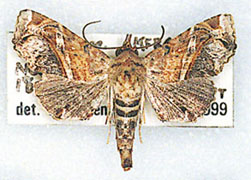 |
| Fig. 5 Bamra lepida | Fig. 6 Targalla transversa |
Noctuidae: Euteliinae
Eutelia flavillatrixoides Poole, 1989; previously noted as E. flavillatrix Walker (sensu Kendrick, 1998a).
Targalla sp. near duplicilinea Walker, 1862 (det. ACG). 1 x 1999; KARC
Targalla transversa (Candèze, 1927) (det. ACG),. 18 viii 1999; Kwun Yam Shan, KFBG.
Noctuidae: Hadeninae
Mythimna argentea Yoshimatsu, 1994 (det. ACG); this is the replacement name for the previously noted Polia fasciata (Leech, 1889) (sensu Kendrick, 1999a), a species originally placed in the genus Hecatera, a synonym of Mythimna, and which is a junior homonym of a different species, Borolia (=Mythimna) fasciata Moore 1881.
Nolidae: Nolinae (transferred from Noctuidae by Holloway, 1998)
Nola lucidalis Walker. 20 ii 1997;KARC.
Nola izuensis Inoue; previously noted as Ididclytta sp. nr. tornotis Meyrick, 1907 (sensu Kendrick, 1998d).There are at least five more species of Nolinae awaiting identification, several are likely to be undescribed.
Bibliography
Galsworthy, A.C. (1999). New and revised eupitheciini species (Geometridae, Larentiinae) from Hong Kong and South East Asia. Trans. Lepid. Soc. Japan 50: 223-234.
Holloway, J.D. 1993 [1994]. The Moths of Borneo: part 11; family Geometridae: subfamily Ennominae. Malayan Nature Journal, 47: 1-309.
Holloway, J.D. (1998). The classification of the Sarrothripinae, Chloephorinae, Camtolominae and Nolinae as the Nolidae (Lepidoptera: Noctuoidea). Quadrifina 1: 247-276.
Kendrick, R.C. (1998a). New moth species for Hong Kong; 1997 records. Porcupine! 17: 14.
Kendrick, R.C. (1998b). Macroglossum saga (Lepidoptera: Sphingidae) finally found in Hong Kong. Porcupine! 17: 15.
Kendrick, R.C. (1998c). Endoclita species (Lepidoptera: Hepialidae) newly recorded in Hong Kong. Porcupine! 17: 15-16.
Kendrick, R.C. (1998d). New moth species for Hong Kong, part 2; 1997-1998 records. Porcupine! 18: 7-8.
Kendrick, R.C. (1999a). New moth species for Hong Kong, part 3; further 1997-1998 records. Porcupine! 19: 11-14.
Kendrick, R.C. (1999b). New moth species for Hong Kong, part 4; 1999 records (mostly). Porcupine! 20: 10.
Schintlmeister, A. (1997). Moths of Vietnam with special reference to Mt. Fan-si-pan; Family: Notodontidae. Entomofauna Zeitschrift für Entomologie. Suppl. 9: 33-248.
|
P.3-4 |
![]()
Orthetrum poecilops Ris - A marine dragonfly of conservation priority
by Keith D.P. Wilson
Introduction
Odonate larvae are generally intolerant of highly saline water. There are two notable exceptions, which are Orthetrum poecilops Ris, from the Old World and Erythrodiplax berenice (Drury), from the New World, both of which can tolerate fully saline seawater. O. poecilops can be found in inter-tidal mudflats amongst Kandelia mangroves in northeast Hong Kong. Three subpopulations have been located at Starling Inlet, two at Nam Chung and one at Hoi Pui Leng. A single specimen has also been recorded from Shuen Wan.
Dragonflies and salinity
Corbet ( 1999 ) reviewed dragonflies tolerance of high conductivity environments and considered only Erythrodiplax berenice could be considered a truly marine dragonfly. This sympetrine dragonfly, which inhabits the coastal marshes between Ecuador and Canada, commonly occurs at salinities of 36-48 0/00 seawater; seawater being typically 350/00. E. berenice is one of the few insects known to tolerate high salinity and has been documented to survive in salinities as high as 70 0/00. Dunkle (2000) describes this species as being the only dragonfly in the western hemisphere that can breed in undiluted seawater.
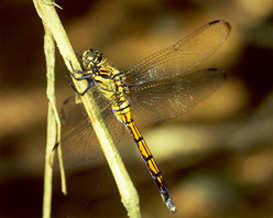 |
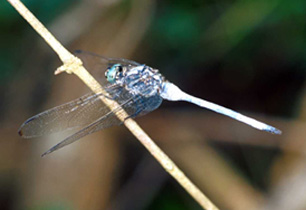 |
 |
Orthetrum poecilops must also be considered a marine dragonfly. It is only found in Hong Kong at sites below the high water mark. Although parts of these sites are influenced by small freshwater trickles and seepages at low tide, at high tide, all the Hong Kong sites are fully covered by seawater. During the wet season salinities of surface seawater at Starling Inlet drop to as low as 18 0/00, or less, but during the winter dry season, surface water salinities are typically fully saline at 33 0/00. |
There are a number of dragonflies, both Anisoptera and Zygoptera, which can also tolerate brackish waters, but at Salinity levels much lower than fully saline conditions. In Japan Mortonagrion hirosei is considered to prefer brackish water habitats. This species also occurs in the vicinity of Starling Inlet, at Luk Keng marsh, where conditions are brackish. In Moore (1997) Mortonagrion hirosei is the only dragonfly recommended, by the IUCN Species Survival Commission Odonata Specialist Group, as a priority species for protection, because of its preference for brackish water conditions. If the rarity and habitat preference of O. poecilops had been fully appreciated by the Odonata Specialist Group it is likely this species would also have been recommended as a priority species for protection for its biology. In Japan Orthetrum poecilops miyajimaensis is already classified as endangered on the IUCN red list, principally due to habitat loss.
Biology
Very little is known of the biology of O. poecilops apart from its preference for intertidal mudflats amongst Kandelia mangroves. In Japan the only known sites are coastal marshes. In Hong Kong males can be found holding territories throughout the day; typically perching on Kandelia mangroves or Phragmites australis reed stems. Females appear at the breeding sites during the early morning and late afternoon. Coupling takes place in a settled, stationary position with the ‘wheel’ stage lasting about 10 minutes, which is quite a long time for a libellulid.
Distribution
The type locality for O. poecilops is Guangdong. It is also known from Foochow, Fujian and from a small island, Miyajima, located off the coast of Hiroshima, Japan.
In 1998 I met Mr. Sawano, who rediscovered Orthetrum poecilops at Miyajima, in 1955, after a gap of some 17 years. Mr. Sawano had come to Hong Kong to help the Chugoku Broadcasting Company, from Hiroshima, to make a television documentary of Orthetrum poecilops. As part of the documentary they filmed breeding sites in both Hong Kong and Japan.
Identification
One of several blue-bodied ‘darter’ dragonflies in Hong Kong. The sides of the body are yellow and black striped, becoming darker with age. It is the only Hong Kong blue libellulid species with a whitish face. It is about 4.5 cm long with a 7 cm wingspan. The females, which are seldom seen, are dull brownish with yellow and black markings. Some of Asahina’s (1970) figures are reproduced here in figs 1-7.
Synonymic notes
Orthetrum poecilops miyajimaensis Yûki & Doi (1938) was originally described as a separate species, from the Japanese island of Miyajima. Asahina and Sawano (1957) synonymised miyajimaensis with poecilops. However, Asahina (1970) reestablished the separate taxonomic status of miyajimaensis, at subspecies level, by creating O. miyajimaensis poecilops. Asahina’s judgement was based principally on the smaller size of miyajimaensis, which has now been shown to be inconsistent and may be related to the timing of emergence within the season (pers. com. Sadayuki Ugai). No structural differences have been identified. O. miyajimaensis poecilops should be treated as a synonym of O. p. poecilops.
Orthetrum poecilops Ris, 1919
Orthetrum poecilops: Ris, 1919: 1091, fig. 627, "Holotype male, IV-1911, Guangdong"; Asahina & Sawano, 1957: 8-12, "2 males, 5 females, 20-III-1955, 18 males, 2 females, 29-VII-1956, Yamashiro-ura, Miyajima, Japan, leg. Sawano".
Orthetrum poecilops poecilops: Asahina, 1970: 200, figs 1-4, 10 males, 11 females, Foochow, Fujian, circa, 1928, leg. Kellogg; Wilson, 1995: 158-159, 165, "Hong Kong"; Wilson, 1997: 41, 68, 1 fig., "Nam Chung, Hong Kong".
Orthetrum poecilops ssp.: Saito & Ogata, 1995: 43, figs 105-106, "Shuen Wan, Nam Chung, Hong Kong".
Orthetrum miyajimaensis: Yûki & Doi, 1938: 153-155, "1 female, Itsukushima (=Miyajima), prov. Hiroshima, Japan, 21-VI-1936"; Sawano, 1966: 9: 4, "larvae, Miyajima , Japan".
Orthetrum poecilops miyajimaensis: Asahina, 1970: 202-203, figs 5-7 (larvae), "Miyajima , Japan".
New material: 3 males, 1 female, Hoi Pui Leng, Starling Inlet, Hong Kong, 3.IX.2000, coll. K.D.P. Wilson.
Discussion
|
There are few Hong Kong examples of internationally rare odonate species occurring in lowland, lentic, freshwater habitats. Rare odonates tend to be found in flowing waters and numbers of rare species typically increase with altitude. With a distribution of Hong Kong to Japan Orthetrum poecilops was probably once a relatively widespread species. However, due to habitat destruction, suitable sites are now rare along southern Chinese and Japanese coastlines. Loss of mangrove habitat in southern China has been well documented. None of the sites in Hong Kong, where O. poecilops has been recorded, are classified as Sites of Special Scientific Interest and none are located within Country Parks. As is often the case in Hong Kong, Country Park boundaries are tantalizingly close but typically lowlands and village environs are excluded. The Country Park boundaries in the case of the O. poecilops sites are less than 0.25 km away. |
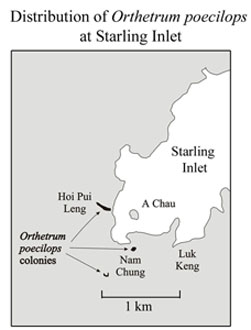 |
There are few Hong Kong examples of internationally rare odonate species occurring in lowland, lentic, freshwater habitats. Rare odonates tend to be found in flowing waters and numbers of rare species typically increase with altitude. With a distribution of Hong Kong to Japan Orthetrum poecilops was probably once a relatively widespread species. However, due to habitat destruction, suitable sites are now rare along southern Chinese and Japanese coastlines. Loss of mangrove habitat in southern China has been well documented.
None of the sites in Hong Kong, where O. poecilops has been recorded, are classified as Sites of Special Scientific Interest and none are located within Country Parks. As is often the case in Hong Kong, Country Park boundaries are tantalizingly close but typically lowlands and village environs are excluded. The Country Park boundaries in the case of the O. poecilops sites are less than 0.25 km away.
Recommendations
In view of its global rarity and its unusual biology the conservation of O. poecilops in Hong Kong should be considered a high priority. It is certainly worth further study to determine its life cycle, quantify its salinity tolerance and determine its habitat requirements.
Bibliography
Asahina, S. (1970). Notes on Chinese Odonata III. Kontyû 38(3): 198-204.
Asahina, S., & J. Sawano. (1957). What is "Orthetrum miyajimaensis Yûki & Doi". Akitu 6: 8-12.
Corbett, P.S. (1999). Dragonflies. Behavior and Ecology of Odonata. Cornell Uni. Press, Ithaca, New York.
Dunkle, S.W. (2000). Dragonflies through binoculars. A field guide to Dragonflies of North America. Oxford University Press, New York. 266 pp.
Moore, N.W. (1997). Dragonflies: Status Survey and Conservation Action Plan. IUCN/SSC Odonata Specialist Group. 27 pp.
Saito, Y and S. Ogata. (1995). Records of Hong Kong dragonflies, collected from June 1994 to October 1995. Bohso no Konchu (15): 25-47. (Jap.)
Sawano, J. (1966). Tombo 9: 4.
Wilson, K.D.P. (1995). Hong Kong Dragonflies. Urban Council of Hong Kong. pp. 211, 265 col. photos.
Wilson, K.D.P. (1997). An annotated checklist of the Hong Kong dragonflies with recommendations for their conservation. Memoirs Hong Kong Natural History Society 21: 1-68, pl. 1.
Yûki., J. & H. Doi. (1938). A new species of Orthetrum. Akitu 1: 153-155.
![]()
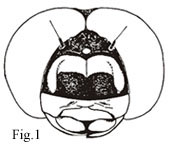 |
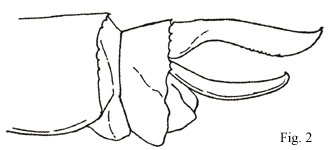 |
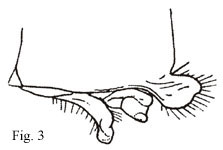 |
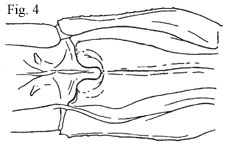 |
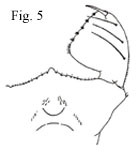 |
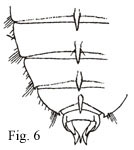 |
Email address of Keith Wilson:wislonhk@hk.super.net |
Figures 1-7, Orthetrum poecilops Ris (from Asahina, 1970). Figs 1-3, male, Foochow, Fujian: (1) head, frontal, (2) caudal appendage, lateral, (3) secondary genital appendages. Fig. 4, female, Foochow, Fujian: (4) valvula vulvae. Figs 5-7, larvae, Miyajima, Japan: (5) labium, (6) caudal abdomen, dorsal, (7) abdomen, lateral.
|
P.5-6 |
![]()
Soil Towers
by R.D. Hill
Rather more than 40 years ago I first read Charles Darwin’s classic monograph on The formation of vegetable mould, through the action of worms: with observations on their habits, published first just a year before he died in 1882. Right through subsequent years of research on agriculture and soils his ideas were tucked away in my memory with the realization that in Hong Kong - so far as I was able to discover - nothing had been done on soil turnover by animals. It took a hill fire at the site of Mervyn Peart’s and my soil erosion study in the New Territories to make me realize just how important this may be. Within a couple of days hitherto blackened slopes began to be sprinkled with yellowish - brown patches of soil ranging in size from a few square centimetres to half a square metre, from a few tens of grams to several tens of kilograms, in all likelihood.
Some unsystematic observations and discussion established that the larger heaps of material were probably the work of porcupines - only one actually seen - and/or ferret badgers - none seen. As these animals are nocturnal or partly so, some fairly sophisticated methods would be needed to study them. Smaller heaps were clearly the work of wasps, ants and termites. The material is fine-grained and formed into weakly aggregated balls about 0.5 to 1.0 mm in diameter. Wasps form a low conical mound, roughly circular in slope, centred upon a hole about 10 cm in diameter. This is of some depth for the colour of the aggregates is the yellowish-brown of the B horizon of our hill soils and this generally extends downwards from around 20 to 50 cm in the profile, not the darker brown of the A horizon. Ants or termites form extensive clay-roofed galleries as well as producing conical mounds like wasps. One well-known gallery-builder is the termite Coptotermes. (In H.K. does this seem have something of an affinity for Acacias?). Ants also build towers. These may be quite slender - 5 am in diameter and up to about 5 cm in height. Others are broader - 2 or 3 cm in diameter and up to 10 cm tall. Which insects build which kinds of towers remains to be established. These towers are quite fragile and are destroyed by heavy rain.
Not so the towers now known to be built by an earthworm. These were first noticed by following a hill fire in 1999 on the ridge leading up to Tai Mo Shan from Kun Yam Shan, though Richard Corlett’s indefatigably keen eye on various H.K. mountain slopes had earlier noticed them. Towers are, for H.K., fairly substantial, long-lasting structures, hard to very hard as soil aggregates, verging on indurated. They are formed as irregularly globular masses of clayey material, some clearly drawn from the A horizon - as evidenced by their colour - some from the B, like that of wasp mounds, more yellow in colour. The towers are about 3 - 4 cm in diameter rising to about 10 cm, exceptionally a little more. Each has a hole about 3 mm in diameter right through the tower.
| Such was the state of my knowledge until this October, when, after having listed "The role of animals in soil turnover" as a final-year undergraduate project for some years, Katie Chick began investigations, focussing on the invertebrates. A first field trip to the Tai Mo Shan ridge above KFBG found plenty of towers, a few inhabited by ants and spiders who clearly appeared to be opportunistic visitors or inhabitants. Out of 20 towers opened up, only one was inhabited by a possible builder, a worm, probably a juvenile, some 3 cm long. A second visit on a wet morning established the presence in abundance of large earthworms, up to 30 cm long and 5-6 mm in diameter. There, at last, was a candidate for tower-building. The visits also established two other things. The tower did not lead into an underground chamber. Some were actually built on a concrete path. The second factwas that these worm-casts - for that is what they are - do not necessarily form towers. The material may be deposited on the ground though still in globular masses.What appears to happen, though this is yet to be directly observed, is that the animal in the central hole in the cast, vents the cast material onto earlier vented material with which it binds. Where active venting occurs, recently deposited material at the top (or side) is soft and somewhat viscous, rather darker and much moister than the earlier deposited material. | |
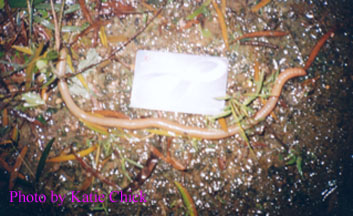 |
The material contains a good deal of clay and probably also mucus to act as a binding agent. This, after drying in the atmosphere, leads to remarkable aggregate stability. An attempt to measure stability by placing bits of cast in a mixture of alcohol and water has shown no dissolution after nearly two months. |
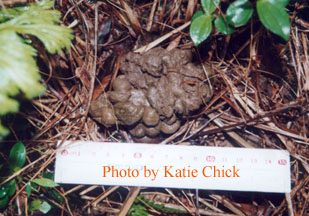 |
Not all H.K. worm casts are as spectacular as these. On hill slopes at lower elevations the casts are much smaller and certainly do not form towers, each probably representing material from a single evacuation. But they too are quite stable having turned up in our erosion traps. Whether such aggregate stability is enhanced by the baking effects of hill fire remains to be established. Casts probably contain significant quantities of soil nutrients though this too is still to be measured. |
| Certainly an anonymous H.K. civil servant was, nearly 50 years ago, convinced that they were important. In his view, one reason why H.K.’s rice-fields gave heavy yields year upon year, without fertilizer, was that large quantities of worm-casts were washed onto them, the hillsides being deliberately fired to aid the process of nutrient transfer. | |
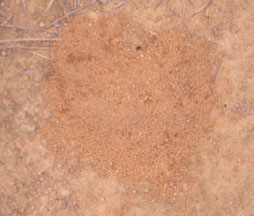 |
 |
| Loose granular material excavated to form a low cone, probably by a wasp. Wong Chuk Yuen. | Broken towers of fine granular material formed by ants or? termites. Wong Chuk Yuen. |
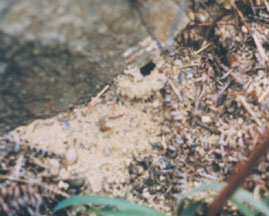 |
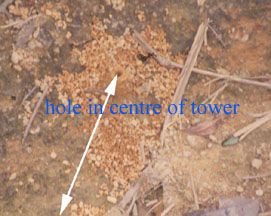 |
| Ant or ? termite tower formed against a rock (greenish-grey surfaces, top left corner). Wong Chuk Yuen. | Ant or ? termite tower in the middle of a low cone of granular material. Wong Chuk Yuen. |
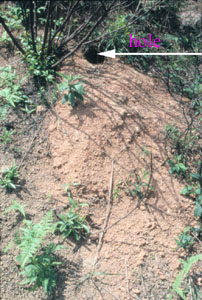 |
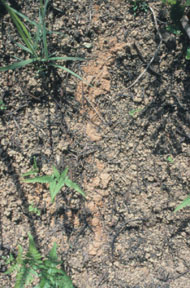 |
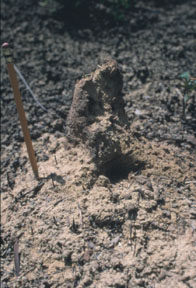 |
| Porcupine? hole with heap of excavated subsoil being slowly moved downslope. Pat Heung. | Termite gallery in a burnt area. Wong Chuk Yuen. | Worm tower with partly-weathered old towers in front. Pencil gives scale. Tai Mo Shan / Kwun Yam Shan Ridge. |
|
P.7 |
![]()
HELP (Earthworm)!
My name is Katie. I’m working for my final year project about earthworms and their castings. I have found one species of earthworms in Kung Yam Shan inside KFBG which excavate huge worm casts on soil surface. However, I can’t identify which species these worms belong to. I still have 3 preserved samples and one live worm sample. Can anyone help me to identify the worm? Please contact me at 91020425 (mobile phone) or at my e-mail : shalala@netteens.net.
THANK YOU VERY MUCH!!
Katie Chick
|
Porcupine! |
 Copyright © 2000 |
